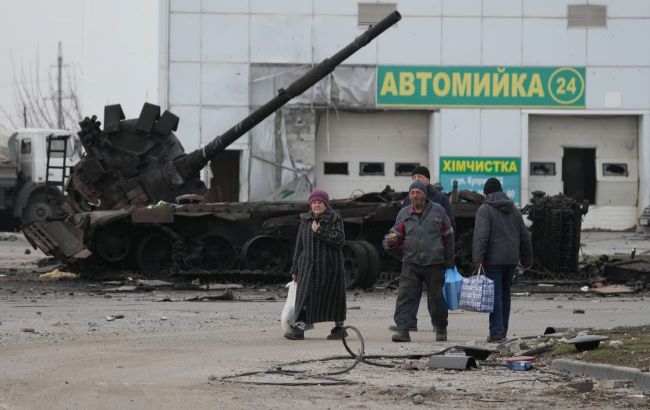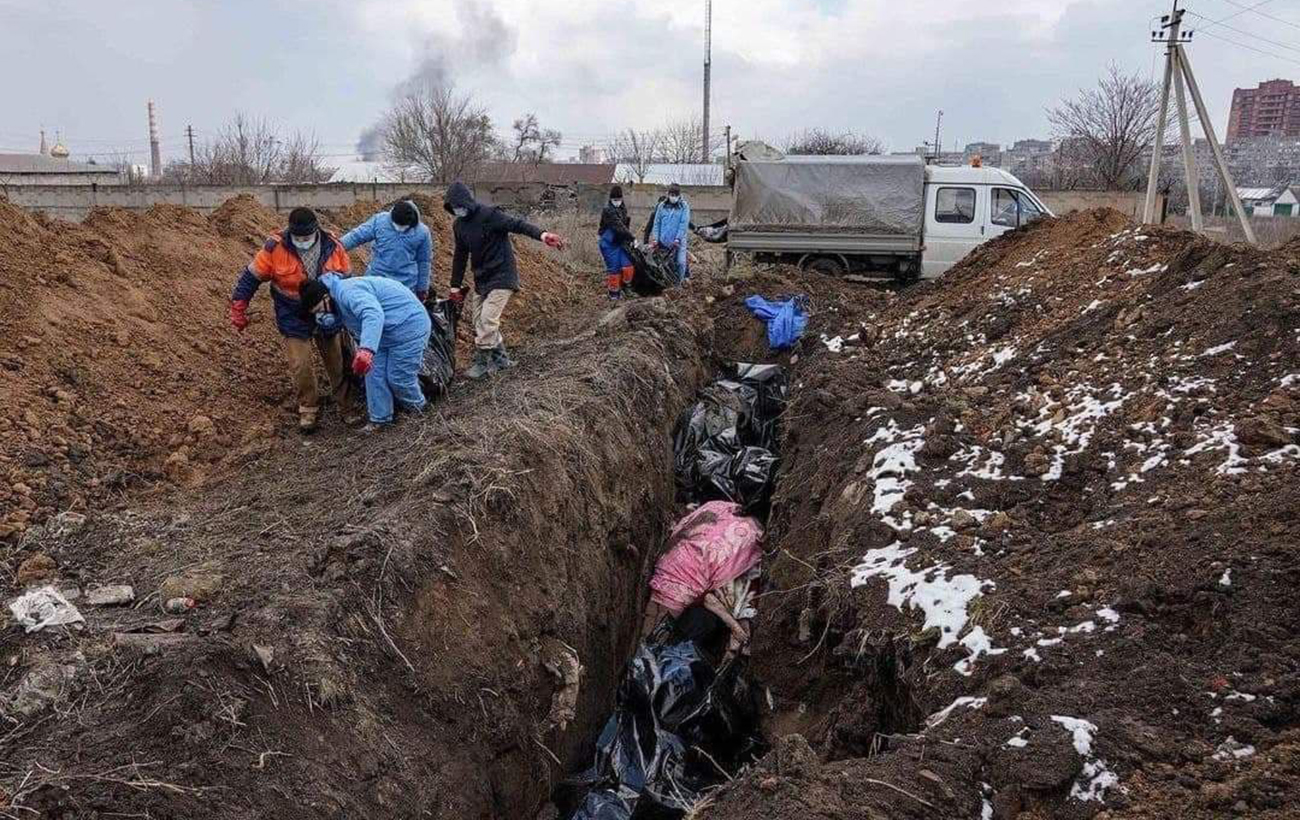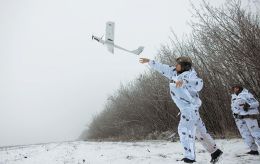'Every street saturated with pain and horror': Main highlights of HRW's investigation into Mariupol
 People in the ruined Mariupol, 2022 (Photo: Getty Images)
People in the ruined Mariupol, 2022 (Photo: Getty Images)
Human Rights Watch, SITU Research, and Truth Hounds have published an investigation dedicated to how Russian forces captured Mariupol in the spring of 2022. According to them, Vladimir Putin, Sergey Shoigu, Ramzan Kadyrov, and others may be involved in war crimes.
RBC-Ukraine provides excerpts from the extensive investigation.
Short overview: Mariupol before and after the invasion
Before the start of the Russian assaults in Mariupol, approximately 540,000 people lived there. The city was an important cultural and industrial center, often hosting various festivals such as Gogolfest. People from all over the country came to see performances at the regional theater or concerts at the chamber philharmonic.
Mariupol was home to two major metallurgical plants. The local government invested hundreds of millions of dollars in road construction, parks, and the creation of a modern public transportation system. The Sea of Azov was both a landmark and a guarantee of development: through the Mariupol port, Ukraine supplied coal, steel, and grain to various parts of the world.
The full-scale Russian invasion began on February 24, 2022. Battles with Russian forces and formations from the occupied areas of Donbas lasted for almost three months. For the aggressor, the capture of Mariupol had strategic importance as part of a land corridor to the Crimea, controlled since 2014.
By March 2, the Russians had completely surrounded the city and began advancing towards the central part. Mariupol was bombed from the air and shelled with tanks, mortars, and heavy artillery. Many residents left their homes and moved to basements; by early March, there were about 450,000 people remaining, who either couldn't or didn't want to evacuate.
During the fighting, many critical infrastructure objects were damaged. Mariupol was left without electricity, water, heating, and communication. By April 13, the occupiers had captured most of the city, and on the 21st, Moscow announced its capture. In mid-May, the remnants of the Ukrainian garrison defending Azovstal surrendered.
The city was unrecognizably changed by the fighting: instead of buildings, there were ruins, and temporary graves were in the yards. Thousands of people died in Mariupol, making it one of the most affected cities in Ukraine in terms of destruction.
 Assessment of destruction in the center of Mariupol (hrw.org)
Assessment of destruction in the center of Mariupol (hrw.org)
Human Rights Watch, SITU Research, and Truth Hounds conducted a joint project to document the damage inflicted on Mariupol. Unable to gather information on-site, they used testimonies from hundreds of evacuated Mariupol residents, analyzed 850 photos and videos, and examined satellite images of cemeteries. To assess the scale of the destruction, human rights defenders studied each quarter in the city center. A separate investigation was conducted to identify specific units and commanders involved in war crimes.
In their work, they focused on the destruction along the central street of the city - Myru Avenue. They studied an area of approximately 14 square kilometers (about a quarter of Mariupol's total area). Within this area, 4884 damaged or completely destroyed buildings were examined. To illustrate the scale of the destruction, three-dimensional models of seven buildings were constructed.
One building was a residential complex, another a hospital with maternity ward №3, and another was a university. The investigation also mentioned a private house, a commercial building with a bank, a shopping center, a playground, a neoclassical-style building in the city center, and the heart of Mariupol - the drama theater.
With the onset of war, these buildings first turned into shelters, and then into places of death. Two years have passed since the storms of Mariupol, attention has shifted to other hot spots, but for the people, life has not returned to normal. The occupiers are demolishing the destroyed buildings and building a new city with a Russian face, and those responsible have not been held accountable. The Mariupol known to locals no longer exists.
House on Mytropolytska Street and buried under the rubble
The investigation recounts the story of the building at Mytropolytska Street 98 and the Antipenko family - Ivan, Khrystyna, and their three-year-old daughter Aryna. In early March, menacing planes circled above the building, the area was shelled from tanks, so the basement seemed the safest shelter. People went out onto the street briefly to fetch water and cook food over a fire.
At around 3:00 p.m. on March 11, an explosion rang out: an aerial bomb brought down the central section - all five floors, and people were buried under the rubble. Those who remained alive called for help; neighbors heard groans, but rescuers were forced to leave due to the shelling. Charred bodies lay on the floor in the basement, nothing remained of the building.
 One of the destroyed buildings in Mariupol (Getty Images)
One of the destroyed buildings in Mariupol (Getty Images)
Telegram chats were filled with messages from people searching for relatives. There was no information about the Antipenko family. On Easter, April 24, a group of men found the body of a child at this address; over the next few weeks, a total of 17 bodies and body fragments were retrieved. According to the workers, the child's body matched the description of three-year-old Aryna. Within two months, the wreckage yielded Khrysyina Antipenko's phone with three unsent messages from March 6: "Mommy, I'm alive. Everything is fine with me. Love you." The phone was handed over to her mother, Stefaniia, who lived in another city.
For several months, she visited the temporary morgue where the deceased from all over Mariupol were brought. Then she found a photo of Aryna's body in the database under number 1734. At the Starokrymske cemetery, it turned out that at the location of number 1734, next to the cross, was a photo of another little girl - Eva, who died in a car shelling. Relatives mistook Aryna's body for their daughter's. In October, Stefaniia obtained permission for exhumation and reburied her granddaughter in another Ukrainian city. The bodies of Ivan and Khrystina were not found; they are considered "missing," most likely their remains are lost among the remains of thousands of other people. In July 2022, Stefaniia handed over her DNA samples to the occupation authorities; at the time of the report's publication, she had not yet received the results of the analysis.
"I used to be a mother and a grandmother, now I am nobody. For me, family was the most valuable treasure, I lived joyfully and happily, and now nothing is left. I beg God only for one thing - to find the bodies of my children and bury them so they can be near me," the woman complains.
Hospital No. 3 and the struggle for survival
In certain areas of Mariupol in the summer of 2014, battles raged between Ukrainian forces and pro-Russian formations for five weeks. Since then, local residents have been living in the front line zone. But over eight years, no one could have imagined that their loved ones would die on the streets, under rubble, and that Mariupol would come under Russian control.
"Every street there is saturated with blood, pain, and horror. It's a trauma that will last for many, many years - perhaps even for generations," says one of the evacuees.
Mariupol changed beyond recognition in just 2-3 weeks. Approximately two and a half kilometers from building No. 98 on Mytropolytska Street stood the blue-green building of Hospital No. 3 - the main hospital in Mariupol for women and children. People came here for gynecological care, childbirth, and brought sick children.
 Map of damaged hospitals in Mariupol (hrw.org)
Map of damaged hospitals in Mariupol (hrw.org)
Dozens of people thought they would be safe on the hospital grounds and hid in the underground shelter. It was an old, reliable but cold bunker, where the temperature at night dropped below zero. To survive, they had to fight for every necessity: where to get water, food, and medicine.
At around 2:50 p.m. on March 9, the roar of an airplane was heard, followed by a powerful explosion, resulting in damage to the maternity ward and the children's diagnostic center. Patients and doctors rushed out into the courtyard; police officers and volunteers carried out Irina Kalinina, who had previously undergone a cesarean section. A few hours later, Iryna died, and the child also perished. After the strike, some hospital staff and patients descended into the shelter. Doctors performed simple surgeries, bandaged wounds, gave injections, and removed debris. The hospital was shelled throughout March.
Thousands of Mariupol residents across the city were in equally dire conditions and desperately tried to survive. The water supply was not functioning, so people collected rainwater and melted snow. Those who hid in the bunker at the hospital were lucky: there was a large old water tank in the room. Nearby, in the park, there was a well, but going there was dangerous.
"The road to the well was littered with corpses. Those who had the courage to go to the well often returned to us as patients, missing limbs," recalls a woman named Diana.
***
It is worth noting another episode related to Hospital No. 3. One of the victims was the blogger Marianna Vyshemyrska, who was in the maternity ward. Her photos, wrapped in a blanket with blood on her face, spread widely in the media. Shortly after giving birth, she left the city and now lives in Moscow. In January 2024, she posted that she had signed in support of Vladimir Putin, who was running for another term.
Pryazovskyi Technical University and the weapon of explosive force
On March 9, just minutes before the bombing of Hospital No. 3, aviation struck the Pryazovkyi Technical University. Before the war, it housed about 200 programs, educating future engineers, metallurgists, transportation specialists, economists, and IT professionals.
One witness, who recorded the moment of the strike on his phone, Mykhailo Puryshev, was the owner of the Evo restaurant located nearby. Students often dropped by there to grab a bite between classes or hang out with friends. But that morning, there was no one there. The university building was no longer a place for learning but a hiding spot.
"I went outside with my phone still filming and saw the horror. I started to cry, for the first time since the start of the attack on the city," he recalls.
 Photo: Pryazovskyi Technical University building after the strike (hromadske.ua)
Photo: Pryazovskyi Technical University building after the strike (hromadske.ua)
Puryshev documented the destruction in real time, posting photos and videos on Telegram, TikTok, Instagram, Facebook, and other social media platforms. Analyzing satellite imagery and information from open sources, human rights defenders found that out of 89 educational institutions in Mariupol, 86 were affected - all 15 universities and 71 out of 74 schools.
Throughout the entire time Russian forces besieged Mariupol, the use of explosive weaponry resulted in numerous casualties. The city was constantly shelled with tanks, heavy artillery, mortars, and MLRS, subjected to missile and bomb strikes.
Explosive weaponry has a wide blast radius and is not designed for precision strikes. The devastating effect was evident in the strike on the building at Marinska Balka Street 67, a 10-minute walk from the Pryazovskyi Technical University. In this area, which housed private homes, according to eyewitnesses, at least 15 of them were completely destroyed.
 The aftermath of the strike on the private sector (hrw.org)
The aftermath of the strike on the private sector (hrw.org)
Mariupol resident Vladyslav recounted that on the night of March 10, he was sleeping with his family in the basement when a plane flew by and a powerful explosion rang out. The house shook, and the ceiling collapsed right on their heads, starting a fire in the neighboring building. According to him, two women next door were crushed by the roof; they cried for help, but tragically perished in the flames.
Marinska Balka is just one of many areas affected by the use of explosive weaponry. Analyzing satellite images, as well as published photos and videos whose authenticity has been confirmed, investigators concluded that 54% of buildings (4884 out of 9043) in the central part of Mariupol were affected. Of the multi-story buildings, 93% suffered damage (433 out of 477), and nearly half of the private homes were affected.
The way the dead were buried and efforts to count the total number
The entire areas in plain sight of people initially turned into battlegrounds, and then into graveyards. A man named Stanislav went out on March 8th to the waterfront to take food to a disabled friend in a five-story building about a mile and a half from Marinska Balka Street 67. Nearby were banks, shops, a shopping center, and a playground.
Later, he went out to smoke and saw three women with two children, after which a slow and heavy explosion occurred. Stanislav saw a bright flash and clouds of smoke. The neighboring building's roof collapsed, and within 10 minutes, he returned to see if there were any casualties and found five bodies. Together with a friend, they moved them to the playground, which became a temporary grave.
While the battles raged, people often did not have the opportunity to bury their loved ones or simply the dead. Sometimes bodies were simply buried in the courtyard of a house or on a football field and makeshift wooden crosses were placed on temporary graves. Sometimes, when the front line was close, a trench was dug and 200 bodies were buried in it at once.
 Fraternity grave in the trenches (Photo: t.me/polkazov)
Fraternity grave in the trenches (Photo: t.me/polkazov)
Death was everywhere in Mariupol; the bodies of the dead lay in apartments and in temporary graves. Boiler room operator Rostyslav ventured out on March 22nd to prepare food. It was in the yard of Myru Avenue 42, opposite the drama theater.
"Suddenly, I heard something hit the building from the other side, from the side of the theater. I saw the whole building shake," he says.
A man ran out of the building shouting that it had been hit, and there were people inside who needed help. Rostyslav and two other men rushed inside and climbed to the ruined apartment, where they found a married couple who had risen for their belongings minutes before the strike. They were crushed by the wall, and both the woman and the man died. The next day, risking his life, Rostyslav left Mariupol, walking 30 kilometers. Those who had cars in operation gathered into convoys at Myru Avenue 42 (one of the gathering points) and left for Zaporizhzhia. The official evacuation did not begin until April 30th. Many fled, leaving their dead relatives unburied. Remains were being recovered until February 2023.
Based on the analysis of five mass burial sites, it was established that from March 2022 to February 2023, at least 10,284 people were buried. This is a minimum estimate; the actual number of deaths is likely much higher. Firstly, not all remains have been recovered yet, and secondly, in some graves, people were buried for several years. At least 8,000 people from this number died either directly as a result of hostilities or due to the difficulties they caused—lack of medical care, clean water, etc.
Experts from Human Rights Watch, SITU Research, and Truth Hounds identified four cemeteries in the city where the number of graves significantly increased: Starokrymske, Novotroitske, Pavlov Street and Vynohradne cemeteries. Thousands of people were buried here in either individual or trench-like graves. In addition, hundreds of burials were found at the Manhush cemetery on the outskirts of Mariupol. The identities of many are still unknown.
It is worth noting that, according to Ukrainian sources, at least 20,000 civilians were killed in the city.
Drama theater and attempts to cover up the traces of war crimes
For many residents of Mariupol, the collective trauma associated with the loss of such a large number of people is exacerbated by what they describe as the city losing its face. Before the Russian invasion, the drama theater was a significant cultural center. The pediment of the theater was adorned with statues of a steelworker, a miner, and a farmer, standing amidst muses.
On March 16, 2022, hundreds of people took shelter inside it. Outside, on the asphalt, the word "Children" was written in large letters with white paint. Shortly before noon, two air bombs were dropped on it. As a result, the central part of the roof was destroyed, as well as parts of the north and south walls. The exact number of casualties has not yet been determined. Human rights activists have reliably confirmed 15 deaths, but according to Ukrainian authorities, it's a matter of several hundred.
.jpg) The shattered drama theater in Mariupol (Photo: Getty Images)
The shattered drama theater in Mariupol (Photo: Getty Images)
Throughout the following year, the occupying authorities almost completely demolished the theater building and surrounded the area with a high fence. In May 2023, a list of 459 buildings slated for demolition appeared. In June, two Russian companies began demolishing the building at Mytropolytska Street 98. In August, the Russian Ministry of Construction announced a plan to "restore" Mariupol within three years. It was developed by the Unified Russian Institute of Urban Planning.
Currently, hundreds of thousands of Mariupol residents are forced to live outside their city. Some of them had to move to other regions of Ukraine, while others are abroad as refugees. At the same time, some are still considered missing.
On February 25, 2023, the Russian authorities staged a concert at the Moscow Luzhniki Stadium to commemorate the anniversary of the invasion. A few weeks later, on March 19, two days after the International Criminal Court issued an arrest warrant for Vladimir Putin, he unexpectedly arrived in Mariupol.
Putin arrived by helicopter at night, drove down Myru Avenue, and inspected the building of the Mariupol Philharmonic located next to the destroyed Drama Theater. The occupiers present the construction work as some kind of "revival," but many Mariupol residents believe it is an attempt to destroy their history.
"With every fence, with every corner, there are memories associated. When you erase memory, you lose your childhood, you lose your home, where you can never return," says one of the local residents.
Other changes are taking place as well. Teachers are forced to sign a document agreeing to switch to the Russian program. History is presented from the Kremlin's perspective: Ukraine is portrayed as a state that is neither sovereign nor independent. Many streets and squares have been renamed, reverting to Soviet names. Television programs are only in Russian, and access to the internet is provided through Russian servers, with access to Ukrainian websites blocked.
As in other occupied territories, anyone who dares to resist these changes or oppose the war and occupation faces arrest, imprisonment, or forced disappearance.
***
To identify the identities of Russian military commanders and units that may be involved in violations of the laws of war and war crimes in Mariupol, extensive work was carried out to collect and study publications on Russian social media and press, obituaries of Russian military personnel, official statements from Russian state officials and military leaders, as well as photo and video materials.
Human rights activists believe that according to the principle of command responsibility, the following 10 individuals may be involved in war crimes:
- Vladimir Putin - President of Russia and Supreme Commander-in-Chief
- Sergey Shoigu - Minister of Defense
- Valery Gerasimov - First Deputy Minister of Defense and Chief of the General Staff
- Sergei Rudskoy - First Deputy Chief of the General Staff
- Alexander Dvornikov - Commander of the Southern Military District at that time
- Viktor Zolotov - Commander-in-Chief of the National Guard (Rosgvardia)
- Andrei Mordvichev - Commander of the 8th Combined Arms Army
- Ramzan Kadyrov - Head of Chechnya and leader of Chechen units
- Adam Delimkhanov - Commander of Chechen units in Mariupol
- Denis Pushilin - Leader of the so-called DPR (Donetsk People's Republic)
Regarding these individuals, as well as possibly other commanders of the 17 units present in Mariupol, an investigation into their involvement in war crimes should be conducted.
"Securing justice for the serious violations that occurred in Mariupol-and across Ukraine-is essential to supporting victims and their families and survivors, and to building confidence in the rule of law globally. It can also play a critical role in deterring future abuses by breaking the patterns of impunity that embolden perpetrators," the report states.

